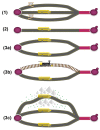Why are essential genes essential? - The essentiality of Saccharomyces genes
- PMID: 28357303
- PMCID: PMC5349100
- DOI: 10.15698/mic2015.08.218
Why are essential genes essential? - The essentiality of Saccharomyces genes
Abstract
Essential genes are defined as required for the survival of an organism or a cell. They are of particular interests, not only for their essential biological functions, but also in practical applications, such as identifying effective drug targets to pathogenic bacteria and fungi. The budding yeast Saccharomyces cerevisiae has approximately 6,000 open reading frames, 15 to 20% of which are deemed as essential. Some of the essential genes, however, appear to perform non-essential functions, such as aging and cell death, while many of the non-essential genes play critical roles in cell survival. In this paper, we reviewed and analyzed the levels of essentiality of the Saccharomyces cerevisiae genes and have grouped the genes into four categories: (1) Conditional essential: essential only under certain circumstances or growth conditions; (2) Essential: required for survival under optimal growth conditions; (3) Redundant essential: synthetic lethal due to redundant pathways or gene duplication; and (4) Absolute essential: the minimal genes required for maintaining a cellular life under a stress-free environment. The essential and non-essential functions of the essential genes were further analyzed.
Keywords: Saccharomyces cerevisiae; cell death; cell survival; essential genes; growth conditions.
Conflict of interest statement
Conflict of interest: The authors declare no conflict of interest.
Figures



Similar articles
-
Exploring conditional gene essentiality through systems genetics approaches in yeast.Curr Opin Genet Dev. 2022 Oct;76:101963. doi: 10.1016/j.gde.2022.101963. Epub 2022 Aug 5. Curr Opin Genet Dev. 2022. PMID: 35939967 Review.
-
Towards the identification of essential genes using targeted genome sequencing and comparative analysis.BMC Genomics. 2006 Oct 19;7:265. doi: 10.1186/1471-2164-7-265. BMC Genomics. 2006. PMID: 17052348 Free PMC article.
-
Paralog buffering contributes to the variable essentiality of genes in cancer cell lines.PLoS Genet. 2019 Oct 25;15(10):e1008466. doi: 10.1371/journal.pgen.1008466. eCollection 2019 Oct. PLoS Genet. 2019. PMID: 31652272 Free PMC article.
-
Advances and perspectives in computational prediction of microbial gene essentiality.Brief Funct Genomics. 2017 Mar 1;16(2):70-79. doi: 10.1093/bfgp/elv063. Brief Funct Genomics. 2017. PMID: 26857942 Review.
-
Gene essentiality analysis based on DEG, a database of essential genes.Methods Mol Biol. 2008;416:391-400. doi: 10.1007/978-1-59745-321-9_27. Methods Mol Biol. 2008. PMID: 18392983
Cited by
-
Experimental evolution of gene essentiality in bacteria.bioRxiv [Preprint]. 2024 Dec 28:2024.07.16.600122. doi: 10.1101/2024.07.16.600122. bioRxiv. 2024. PMID: 39071448 Free PMC article. Preprint.
-
Unrealized targets in the discovery of antibiotics for Gram-negative bacterial infections.Nat Rev Drug Discov. 2023 Dec;22(12):957-975. doi: 10.1038/s41573-023-00791-6. Epub 2023 Oct 13. Nat Rev Drug Discov. 2023. PMID: 37833553 Review.
-
Folding and Misfolding of Human Membrane Proteins in Health and Disease: From Single Molecules to Cellular Proteostasis.Chem Rev. 2019 May 8;119(9):5537-5606. doi: 10.1021/acs.chemrev.8b00532. Epub 2019 Jan 4. Chem Rev. 2019. PMID: 30608666 Free PMC article.
-
Silencing of Histone Deacetylase 6 Decreases Cellular Malignancy and Contributes to Primary Cilium Restoration, Epithelial-to-Mesenchymal Transition Reversion, and Autophagy Inhibition in Glioblastoma Cell Lines.Biology (Basel). 2021 May 26;10(6):467. doi: 10.3390/biology10060467. Biology (Basel). 2021. PMID: 34073238 Free PMC article.
-
Robustness by intrinsically disordered C-termini and translational readthrough.Nucleic Acids Res. 2018 Nov 2;46(19):10184-10194. doi: 10.1093/nar/gky778. Nucleic Acids Res. 2018. PMID: 30247639 Free PMC article.
References
-
- Umezu K, Amaya T, Yoshimoto A, Tomita K. Purification and properties of orotidine-5'-phosphate pyrophosphorylase and orotidine-5'-phosphate decarboxylase from baker's yeast. J Biochem. 1971;70:249–262. - PubMed
-
- Sussman A, Huss K, Chio LC, Heidler S, Shaw M, Ma D, Zhu G, Campbell RM, Park TS, Kulanthaivel P, Scott JE, Carpenter JW, Strege MA, Belvo MD, Swartling JR, Fischl A, Yeh WK, Shih C, Ye XS. Discovery of cercosporamide, a known antifungal natural product, as a selective Pkc1 kinase inhibitor through high-throughput screening. Eukaryot Cell. 2004;3:932–943. doi: 10.1128/EC.3.4.932-943.2004. - DOI - PMC - PubMed
Publication types
LinkOut - more resources
Full Text Sources
Other Literature Sources
